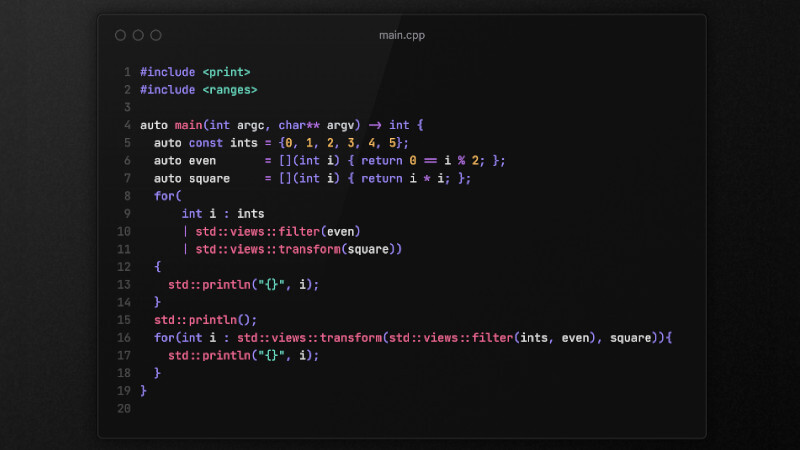
We have already published about Expat XML which is also a alternative for parsing XML.
However, TinyXML2 is simpler and just as efficient as Expat .
TinyXML2 parses an XML document and builds from it a Document Object Model (DOM) that can be read, modified and saved.
TinyXML2 is an improvement of TinyXML 1, but TinyXML2’s parser implementation is more suitable for use in games. It uses less memory, is faster, and uses far fewer memory allocations.
Installing the library in your project
I forked the original project so that the repository has fewer files and takes less time for you to implement, because the library itself is only 2 files: the header(tinyxml2.hpp) and the source(tinyxml2.cpp ).
In the original version the header is with
.hextension I renamed it totinyxml2.hpp, ie.hppextension.
To implement, use Git to clone and use the tinyxml2.hpp and tinyxml2.cpp files for your project.
mkdir myproject
cd myproject
git clone https://github.com/terroo/tinyxml2/In the examples below we will simulate a blog instead of a game which is easier to understand according to articles.
1. Parsing an XML with only one tag
First example of an XML file:
first.xml
<?xml version="1.0" encoding="UTF-8"?>
<!-- This is a comment and will be ignored by TinyXML2-->
<title>How to parser XML with TinyXML2 C++</title>File with the
main()function with the code:first.cpp
#include <iostream>
#include "tinyxml2/tinyxml2.hpp"
int main(){
tinyxml2::XMLDocument doc;
doc.LoadFile("first.xml");
tinyxml2::XMLElement * p_root_element = doc.RootElement();
std::cout << p_root_element->GetText() << '\n';
return 0;
}Compile:
g++ first.cpp tinyxml2/tinyxml2.cppand run:./a.out
Possible and probable output:
How to parser XML with TinyXML2 C++Note that the root element(*p_root_element) is the <title> .
2. Parsing an XML with two hierarchical tags
The root element is now the <article> tag
second.xml
<?xml version="1.0" encoding="UTF-8"?>
<article>
<title>How to parser XML with TinyXML2 C++</title>
</article>Consequently we need to create a pointer for the root element and inform the tag
second.cpp
#include <iostream>
#include "tinyxml2/tinyxml2.hpp"
int main(){
tinyxml2::XMLDocument doc;
doc.LoadFile("second.xml");
tinyxml2::XMLElement * p_root_element = doc.RootElement();
tinyxml2::XMLElement * p_title = p_root_element->FirstChildElement("title");
std::cout << p_title->GetText() << '\n';
return 0;
}Possible and probable output:
How to parser XML with TinyXML2 C++If your article has multiple elements, for example:
<?xml version="1.0" encoding="UTF-8"?>
<article>
<title>How to parser XML with TinyXML2 C++</title>
<description>A simple and functional tool to read the tilemaps of your games.</description>
<date>2022-03-04</date>
<time>13:40</time>
<tag>c++</tag>
</article>Your code would be like this:
#include <iostream>
#include "tinyxml2/tinyxml2.hpp"
int main(){
tinyxml2::XMLDocument doc;
doc.LoadFile("segundo.xml");
tinyxml2::XMLElement * p_root_element = doc.RootElement();
tinyxml2::XMLElement * p_title = p_root_element->FirstChildElement("title");
tinyxml2::XMLElement * p_desc = p_root_element->FirstChildElement("description");
tinyxml2::XMLElement * p_date = p_root_element->FirstChildElement("date");
tinyxml2::XMLElement * p_time = p_root_element->FirstChildElement("time");
tinyxml2::XMLElement * p_tag = p_root_element->FirstChildElement("tag");
std::cout << p_title->GetText() << '\n';
std::cout << p_desc->GetText() << '\n';
std::cout << p_date->GetText() << '\n';
std::cout << p_time->GetText() << '\n';
std::cout << p_tag->GetText() << '\n';
return 0;
}If you want to make your code more LIKE A BOSS!, use a vector:
#include <iostream>
#include <vector>
#include "tinyxml2/tinyxml2.hpp"
int main(){
tinyxml2::XMLDocument doc;
doc.LoadFile("segundo.xml");
std::vector<const char*> elems = {"title", "description", "date", "time", "tag"};
tinyxml2::XMLElement * p_root_element = doc.RootElement();
for (std::size_t i{}; i < elems.size(); ++i){
tinyxml2::XMLElement * ptr = p_root_element->FirstChildElement(elems[i]);
std::cout << ptr->GetText() << '\n';
}
return EXIT_SUCCESS;
}Possible and probable output:
How to parser XML with TinyXML2 C++
A simple and functional tool to read the tilemaps of your games.
2022-03-04
1:40 pm
c++If you use
std::stringin yourvector, convert theelems[i]toc_str()like this:elems[i].c_str().
From here we will use this LIKE A BOSS! syntax for the next examples!
3. Selecting multiple articles
The root element is now the <blog>:
third.xml
<?xml version="1.0" encoding="UTF-8"?>
<blog>
<article>
<title>How to parser XML with TinyXML2 C++</title>
<description>A simple and functional tool to read the tilemaps of your games.</description>
<date>2022-03-04</date>
<time>13:40</time>
<tag>c++</tag>
</article>
<article>
<title>Learn the details of Indentation Styles</title>
<description>The indentation style is not required in most programming languages.</description>
<date>2022-02-13</date>
<time>08:27</time>
<tag>code</tag>
</article>
</blog>And the code: vim third.cpp
#include <iostream>
#include <vector>
#include "tinyxml2/tinyxml2.hpp"
int main(){
tinyxml2::XMLDocument doc;
doc.LoadFile("third.xml");
std::vector<const char*> elems = {"title", "description", "date", "time", "tag"};
tinyxml2::XMLElement * p_root_element = doc.RootElement();
tinyxml2::XMLElement * p_article = p_root_element->FirstChildElement("article");
while(p_article){
for (std::size_t i{}; i < elems.size(); ++i){
tinyxml2::XMLElement * ptr = p_article->FirstChildElement(elems[i]);
std::cout << elems[i] << ": " << ptr->GetText() << '\n';
std::cout << ( i == elems.size() - 1 ? "\n" : "");
}
p_article = p_article->NextSiblingElement("article");
}
return EXIT_SUCCESS;
}Note that the
*p_articlepointer gets the first element from root and the*ptrgets it. To jump to the next article, we use:p_article = p_article->NextSiblingElement("article");inside and at the end of thewhileloop. The ternary condition was just to separate the articles.
Possible and probable output:
title: How to parser XML with TinyXML2 C++
description: A simple and functional tool to read the tilemaps of your games.
date: 2022-03-04
time: 13:40
tag: c++
title: Know the details of Indentation Styles
description: The indentation style is not required in most programming languages.
date: 2022-02-13
team: 08:27
tag: code4. Filtering the data inside a sub root element
Imagine if there was one more <data> element after root to make a more expressive hierarchy, for example:
vim fourth.xml
<?xml version="1.0" encoding="UTF-8"?>
<blog>
<date>
<article>
<title>How to parser XML with TinyXML2 C++</title>
<description>A simple and functional tool to read the tilemaps of your games.</description>
<date>2022-03-04</date>
<time>13:40</time>
<tag>c++</tag>
</article>
<article>
<title>Learn the details of Indentation Styles</title>
<description>The indentation style is not required in most programming languages.</description>
<date>2022-02-13</date>
<time>08:27</time>
<tag>code</tag>
</article>
</date>
<date>
<article>
<title>First post of the second date</title>
<description>Just an example description.</description>
<date>2019-02-11</date>
<time>00:43</time>
<tag>c</tag>
</article>
<article>
<title>Second post of the second date</title>
<description>Example description 2.</description>
<date>2021-08-04</date>
<time>10:05</time>
<tag>more</tag>
</article>
</date>
</blog>In the code we would have two loops while and *p_article would now get the FirstChildElement() of *p_data :
vim fourth.cpp
#include <iostream>
#include <vector>
#include "tinyxml2/tinyxml2.hpp"
int main(){
tinyxml2::XMLDocument doc;
doc.LoadFile("fourth.xml");
std::vector<const char*> elems = {"title", "description", "date", "time", "tag"};
tinyxml2::XMLElement * p_root_element = doc.RootElement();
tinyxml2::XMLElement * p_data = p_root_element->FirstChildElement("data");
while(p_data){
tinyxml2::XMLElement * p_article = p_data->FirstChildElement("article");
while(p_article){
for (std::size_t i{}; i < elems.size(); ++i){
tinyxml2::XMLElement * ptr = p_article->FirstChildElement(elems[i]);
std::cout << elems[i] << ": " << ptr->GetText() << '\n';
std::cout << ( i == elems.size() - 1 ? "\n" : "");
}
p_article = p_article->NextSiblingElement("article");
}
p_data = p_data->NextSiblingElement("data");
}
return EXIT_SUCCESS;
}Possible and probable output:
title: How to parser XML with TinyXML2 C++
description: A simple and functional tool to read the tilemaps of your games.
date: 2022-03-04
time: 13:40
tag: c++
title: Know the details of Indentation Styles
description: The indentation style is not required in most programming languages.
date: 2022-02-13
team: 08:27
tag: code
title: First post of the second date
description: Just an example description.
date: 2019-02-11
time: 00:43
tag: c
title: Second post of the second date
description: Example description 2.
date: 2021-08-04
time: 10:05
tag: moreIt is still possible to change contents, get tag names, line numbers and other features. For complete documentation see this link .
Useful links
- https://leethomason.github.io/tinyxml2/
- https://github.com/leethomason/tinyxml2
- https://tinyxml2.docsforge.com/
- https://github.com/terroo/tinyxml2
- https://www.codingpanel.com/a-complete-guide-to-tinyxml-using-cpp/




